The Coming Revolution in Oncology Biomarker Testing
Pieter De Richter explores how the molecular diagnostics landscape-and the very way we think about fighting cancer-is set to change dramatically in the coming decades.
Pieter De Richter explores how the molecular diagnostics landscape, and indeed the very way we think about fighting cancer, is set to change dramatically in the coming decades.
On the cusp: from evolution to revolution
The clinical management of cancer patients has undergone a remarkable evolution in the past decade, with oncologists now having a range of biomarker tests at their disposal to make a more informed and personalized drug choice. Notwithstanding the added complexity such testing brings, this approach ultimately benefits physicians and patients alike; treatments which are likely to lead to better response rates and more prolonged responses can be selected based on molecular characteristics exhibited by the patient’s tumor.
However, we are only just emerging from the initial exploratory stages of oncology biomarker testing. As will be argued in this article, we are on the cusp of a much more radical revolution, and the molecular diagnostics landscape is set to change even more dramatically in the coming decades. It is crucial that any company entering this space prepare for this imminent upheaval and plan their launch strategy accordingly.
Phase change: from solids to liquids
The central principle at the core of using molecular diagnostics to inform treatment decisions is that the patient’s tumor exhibits certain aberrant characteristics that predispose it to interventions at the molecular level. Unless inherited through the germline, these mutations are not present in non-malignant cells in the patient’s body, and therefore it is no surprise that the traditional approach for tumor biomarker testing for patients with solid cancers relies heavily on obtaining tissue samples from the actual tumor. This, unfortunately, comes with several drawbacks: initial biopsies used in diagnosis don’t always contain enough viable tissue for testing, biopsy samples cannot be stored indefinitely without degrading, there is considerable intra-tumor genetic heterogeneity, and re-biopsies are often invasive. The latter point is particularly important when it comes to patients who have experienced a disease progression, which may be indicative of the tumor having acquired novel somatic mutations not present at the time the initial biopsy was taken.
For some time, it seemed that this was to be accepted as an inherent limitation of solid tumor biomarker testing. It turned out, however, that it was possible to recruit one of cancer’s main weapons to help fight it. Solid tumors begin as small groups of localized malignant cells at the primary tumor site, but ultimately become much more dangerous to the host body by spreading to distant organs. Cancer metastasizes by shedding cells from the primary tumor, which enter the lymphatic system and/or the bloodstream and travel to distant sites. The discovery of these so-called circulating tumor cells (CTCs) as well as cell-free circulating tumor DNA (ctDNA) and RNA (ctRNA), led to the theoretical possibility for detection of mutations in the blood, through so-called “liquid biopsies”.
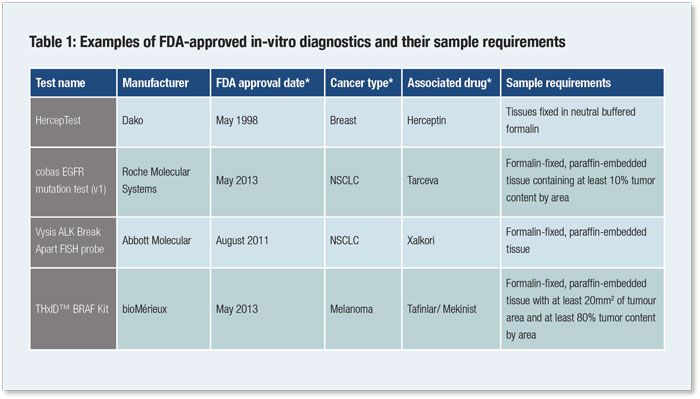
With the improvement in sensitivity of nucleic acid sequencing techniques and an associated drop in cost, this only became a practical possibility in the last few years. The first FDA approval of a commercial liquid biopsy-based assay happened in June 2016: the Roche cobas EGFR Mutation Test v2. Prior to this date, the kit was already available and approved for detecting sensitizing EGFR mutations in formalin-fixed paraffin-embedded (FFPE) tissue samples. The label extension allowed the kit to be used for identifying those mutations based on ctDNA. As the FDA approval at the time stated, “this new test may benefit patients who may be too ill or otherwise unable to provide a tumor specimen for EGFR testing.”
This was followed by the further label extension of this test kit as a companion diagnostic for osimertinib three months later, based on the detection of T790M resistance mutations in blood or tissue samples. Importantly, the clinical and practical benefit of being able to test for resistance mutations based on blood samples exceeds that of testing for (initial) sensitizing mutations. As most testing for sensitizing mutations is done at diagnosis, there is usually enough tissue available based on the initial biopsy (or resection) that was performed to confirm the cancer diagnosis, limiting the need for blood-based tests. On the other hand, testing for resistance mutations requires a new sample to be collected to detect any newly acquired mutations after treatment failure. Furthermore, there may be a benefit to regularly conducting tests for resistance mutations, to track the evolution of the genetic make-up of the tumor during its exposure to targeted therapies. Hence, with liquid biopsies removing many of the barriers relating to re-testing, we can expect the use of liquid biopsies for biomarker testing to show steady growth in the coming years from its current low levels (see Fig. 1).
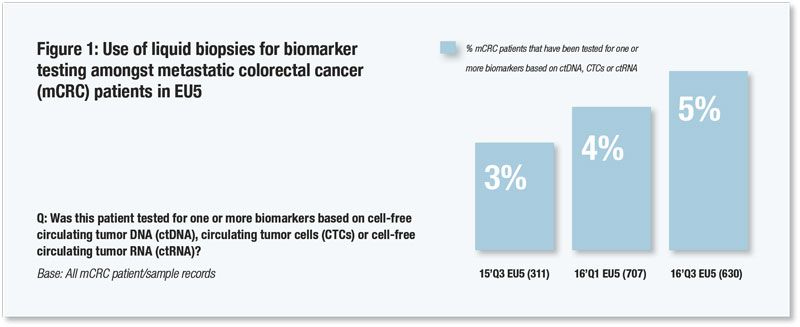
Fig 1: Data were extracted from real, de-identified patient records, and physicians were asked, for each patient: "Was this patient tested for one or more biomarkers based on cell-free circulating tumor DNA (ctDNA), circulating tumor cells (CTCs) or cell-free circulating tumor RNA (ctRNA)?" Note that all patient records in this study were tested for at least one biomarker. Source: Ipsos EU Solid Tumors MDx Monitor 2015 Q3, 2016 Q1, 2016 Q3; research conducted online August-October 2015, March-April 2016, August-November 2016.
Indeed, since 2015, a range of single-marker tests based on liquid biopsies have been made commercially available (some as non-FDA-approved lab-developed tests), covering a range of different markers and cancer types, as illustrated in Table 2:
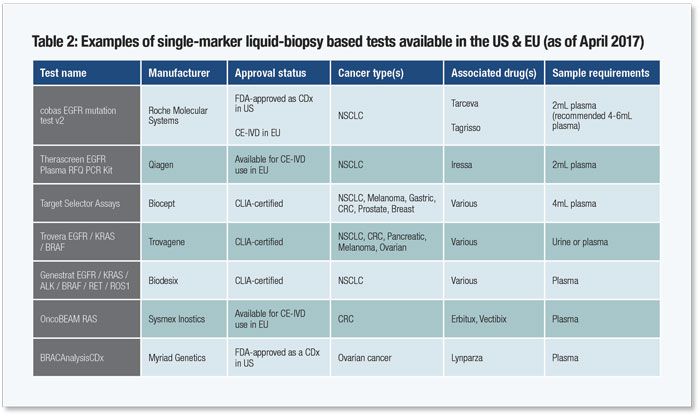
As innovative and promising as these tests are, they still represent a fundamentally unchanged approach in terms of what markers are being tested: each of the tests listed above looks for mutations/changes in expression levels of single genes or proteins (though some laboratories allow for multiple individual markers to be requested at the same time). Cancer, however, is a hugely complex disease and involves the interaction between many different such genes and proteins. Single-marker tests, even when used in combination, only scratch the surface of the molecular mechanics underpinning each patient’s tumor.
Strength in numbers: from single-marker tests to pan-cancer testing panels
The inherent limitations of single-marker tests are two-fold:
i. Genes do not act in isolation.
Single-marker approaches fail to address the fact that the transformation of healthy cells into cancer cells is often the result of a combination of mutations acting together, affecting intricate signaling pathways within and between cells.
ii. Not all cancers exhibit mutations commonly found in that cancer type.
Clinical trials have understandably focused on alterations that are relatively frequently observed in the target population. However, just testing for those particular biomarkers would not identify any of the many potential rare abnormalities. By extension, certain mutations are very common in certain cancer types only (for example, KRAS mutations in colorectal carcinoma), but rare in other cancers, and are therefore often bypassed in the testing process in favor of more common mutations in those cancers (for example, BRAF mutations in melanoma). The fact that they are less common, however, does not mean they are non-existent: KRAS mutations can be found in approximately 0.7% of all melanomas.
Until relatively recently, the only way to overcome those limitations was to increase the number of single-marker tests performed on individual cancer tissues: in melanoma for example, separate BRAF, KRAS, NRAS and PIK3CA mutation tests could be performed to detect less common aberrations and to gain more insight into the specific molecular characteristics of that patient’s cancer. However, this approach requires more viable tumor tissue, significantly complicates the testing workflow, and multiplies the cost of testing. Hence, using this approach beyond four or five different genes is usually not feasible in practice.
The significant cost reduction of next generation sequencing (NGS) has resulted in a way to approach this problem from a different angle: rather than testing each gene individually, sophisticated gene panels aim to sequence a large number of genes simultaneously. The output then provides a mutational status for each of those many genes in one go, greatly increasing the available information regarding that patient’s tumor.
The cost and complexity of NGS meant that this used to be limited to somewhat experimental panels in large academic institutions. In the past few years, however, several companies have launched and marketed commercial testing panels as integrated solutions: doctors are able to send samples for analysis to those companies’ dedicated laboratories, and will receive reports on the genetic characteristics of the tumor, complete with treatment and/or clinical trial recommendations.
Importantly, most are marketed as tumor-agnostic, or pan-cancer, testing panels, meaning that they can be used for any of a wide range of cancers. The number of such panels has exploded in the last few years; Figure 2 shows the market shares of just a selection of those panels currently marketed in the US. Also included is the aggregate total of in-house test panels (panels developed for use in specific academic institutions only and not available as branded solutions).
Fig 2: Pan-cancer test panel shares for selected commercial panel compared to the total share of in-house test panels. Source: Ipsos US Pan-Cancer Testing Monitor 2016 Q3; research conducted online September-November 2016.
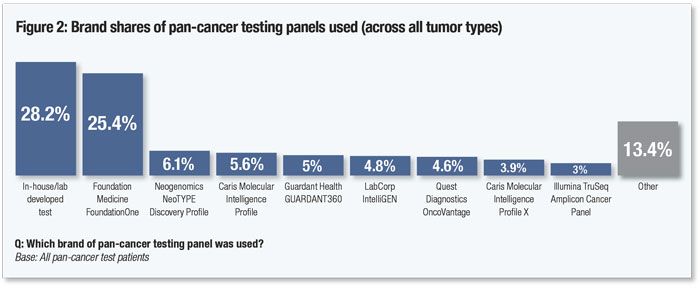
Fig 2: Pan-cancer test panel shares for selected commercial panel compared to the total share of in-house test panels. Source: Ipsos US Pan-Cancer Testing Monitor 2016 Q3; research conducted online September-November 2016.
The sum of the parts: liquid pan-cancer testing panels
These major new developments – clinically useful liquid biopsies and pan-cancer testing panels – arrived on the scene at around the same time. Several diagnostics companies have since started working on products that focused on where those two new technologies converged: pan-cancer testing panels based on liquid biopsies. The key challenge to Next Generation Sequencing of ctDNA is that the concentrations of mutated DNA fragments are typically so low that the signal is obscured by the noise inherent in NGS machines. Hence, dramatic improvements in specificity were required to move beyond single marker testing towards sequencing complete exons in multiple gene targets.
Several diagnostics manufacturers appear to have successfully overcome this, and various such liquid biopsy testing panels are now available at commercial laboratories in the US. Two such examples are:
• Foundation Medicine FoundationACT
As of late 2016, these liquid biopsy testing panels made up a small proportion of all pan-cancer testing panels (Fig. 3), which in turn made up a small proportion of all oncology biomarker testing. It is uncertain just how significant their eventual impact will be, but it is certainly an area that will continue to develop further in the coming months and years.
Fig 3: Liquid-biopsy based pan-cancer testing panels vs. tissue-based pan-cancer testing panels. Source: Ipsos US Pan-Cancer Testing Monitor 2016 Q3; research conducted online September-November 2016
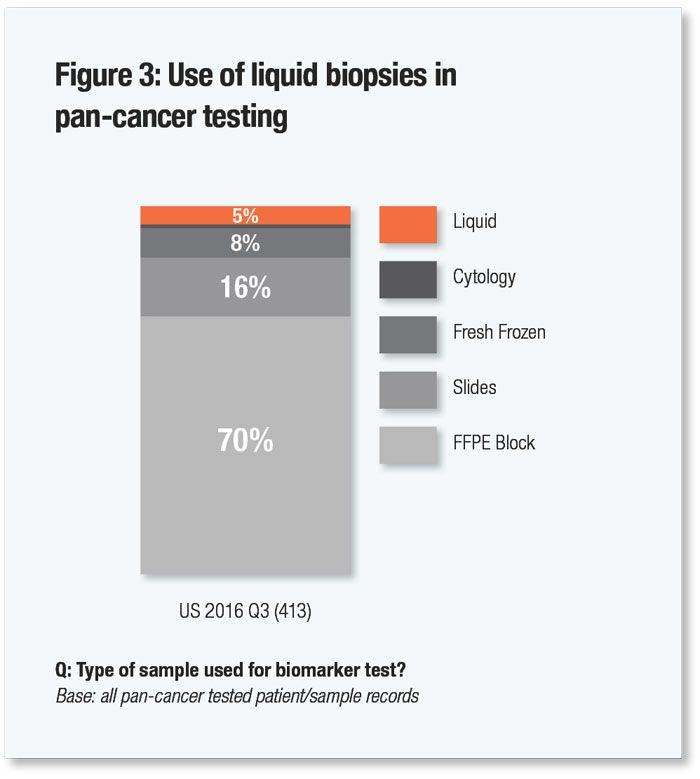
Fig 3: Liquid-biopsy based pan-cancer testing panels vs. tissue-based pan-cancer testing panels. Source: Ipsos US Pan-Cancer Testing Monitor 2016 Q3; research conducted online September-November 2016
One of the major perceived drawbacks of pan-cancer testing panels – whether based on solid tumor samples or liquid biopsies – is that they sometimes deliver an unmanageable amount of information, which is not always actionable. Being able to identify rare mutations in cancer types does provide additional insights in theory, but if no drugs are available to target those mutations, it potentially leaves both oncologist and patient with more questions than answers. Still, it could facilitate patient selection for and enrolment into novel clinical trials, as illustrated by Fig. 4.
Fig 4: Impact on treatment for US patients tested with pan-cancer testing panels, based on de-identified patient record data. Over 1 in 3 pan-cancer test panels led to a change in treatment for that patient. Source: Ipsos US Pan-Cancer Testing Monitor 2016 Q3; research conducted online September-November 2016
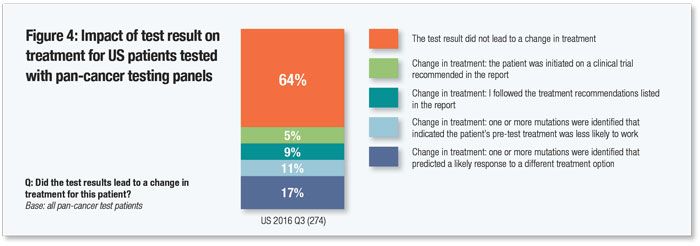
Fig 4: Impact on treatment for US patients tested with pan-cancer testing panels, based on de-identified patient record data. Over 1 in 3 pan-cancer test panels led to a change in treatment for that patient. Source: Ipsos US Pan-Cancer Testing Monitor 2016 Q3; research conducted online September-November 2016
Looking ahead: the coming molecular intelligence revolution
The advances discussed in the previous chapters are, while revolutionary, still fundamentally variations on the same basic approach: cancer cells or their genetic material (either tissue-bound or suspended in a liquid) are extracted, sent for analysis to a laboratory and analyzed by a pathologist or related specialist, after which a report is generated and sent to the oncologist, who is then required to make a treatment decision. Though immensely useful from a clinical perspective, this approach is far from perfect, due to a number of fundamental limitations: (1) cancer cell populations are in a constant state of flux, (2) genes do not act in isolation and epigenetic alterations are also important, (3) the aforementioned risk of information overload increases exponentially with the number of genes/codons added, (4) biomarker testing is currently reactive and largely done post-diagnosis.
Addressing each of these points will require several technological advances, but there are clear indications that the whole field of cancer biomarker testing is going to be radically different in the coming decades, with several major areas of research likely to make a significant impact. At some point in the not-too-distant future, highly sensitive chips in individuals’ bodies may detect somatic alterations as they arise, sending this information in real time to powerful AI software, which will recommend a clinical course of action to be undertaken based on the wealth of molecular diagnostics information continuously transmitted through the chips’ sensors. This approach would represent personalized medicine taken to the extreme, and these systems would even continue to improve further through deep learning algorithms.
The next – and perhaps ultimate – step in the more distant future would be pairing this ability with nanobots permanently inhabiting individuals’ bodies, dispensing targeted doses of highly specific drug cocktails, or physically destroying wayward cells, in an extremely localized matter in response to the information passed to them through the chips and AI agents.
We are on our way to conquering the complexity that makes curing cancer so difficult, but we are not there yet; technology has a lot of catching up to do before such a vision can be realized. However, one thing is for certain: we are only at the very start of an accelerating revolution in molecular diagnostics. To assume that the same logistical touch points, stakeholders, market forces and dynamics that shape the Oncology MDx market now are going to remain relevant in the coming decades would be very risky indeed.
Pieter De Richter is Head of Molecular Diagnostics Portfolio, Ipsos Healthcare.
Is Artificial Intelligence a ‘Product’? Products Liability Implications for AI-Based Products
April 10th 2025As the physical products we use evolve to become increasingly complex, traditional products liability frameworks may not always fit to provide remedies for harm that can result from using novel product types.